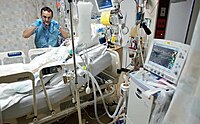
Photo from wikipedia
Initial correspondence from Drs. Laurent, Schonfeld and Bianchi Dear Editor, Hawryluck and Brindley [1] recently addressed the issue of burnout—a syndrome thought to be induced by job stress—among critical care… Click to show full abstract
Initial correspondence from Drs. Laurent, Schonfeld and Bianchi Dear Editor, Hawryluck and Brindley [1] recently addressed the issue of burnout—a syndrome thought to be induced by job stress—among critical care medicine (CCM) practitioners. Although we agree that the practice of CCM can be stressful, relying on burnout as an indicator of the practitioners’ response to occupational adversity is unwarranted. Despite its popularity, burnout remains poorly defined [2]. Disconcertingly, investigators have widely relied on the Maslach Burnout Inventory (MBI) for “diagnosing” burnout in spite of the fact that the MBI is not a diagnostic instrument [2, 3]. Experiencing fatigue or distancing oneself from one’ work—what burnout is about—is not a sign of ill-being in itself [2]. Unfortunately, the MBI does not allow investigators to determine when fatigue and distancing reach clinically relevant levels. The nosological blur surrounding burnout leads to endless speculations regarding the prevalence of the phenomenon and the “threat” it may represent, a state of affairs that bears on interventional resource allocation and public health policy-making [2, 3]. In many respects, current research on burnout’s prevalence looks like a “bubble,” in which ever-increasing estimates are spotlighted in the absence of any clear link to clinical reality. Instead of speculating on the prevalence of burnout, we recommend that occupational health specialists focus on depressive disorders, that is to say, on diagnosable stress-related afflictions [2]. A close follow-up of CCM practitioners would be crucial in order to identify improvements or deteriorations in CCM practitioners’ health status over time as a function of working conditions.
Journal Title: Intensive Care Medicine
Year Published: 2018
Link to full text (if available)
Share on Social Media: Sign Up to like & get
recommendations!